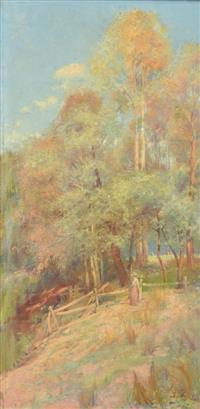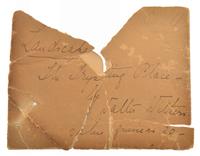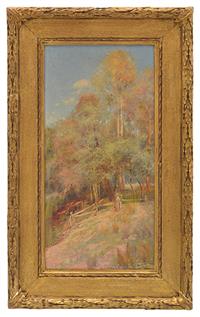Lot 34
The Trysting Place c.1891
oil on canvas
stamped verso (on canvas): PREPARED BY WINSOR & NEWTON/ LIMITED/ 38 RATHBONE PLACE, LONDON, W.
accompanied by a contemporary envelope inscribed: Small/ Landscape/ The Trysting Place -/ by Walter Withers/ value guineas 20 -
inscribed verso on stretcher, in pencil: 'Fink', and framing instructions
61.5 x 30.5cm
Estimate $120,000 - $180,000
Mr. Theodore Fink, Melbourne
Thence by descent
Private collection, Melbourne
Walter Withers Studio Exhibition, Mutual Provident Building, 463 Collins Street, Melbourne, 14-28 May 1891, no. 3
Exhibition of the Works of Victorian Artists, National Gallery of Victoria, Melbourne, November 1891, no. 9, £21 [20 guineas]
The Herald, Melbourne, 13 May 1891
'Mr Wither's collection of paintings', The Age, Melbourne, 14 May 1891, p. 7
'Art Notes', The Argus, Melbourne, 15 May 1891, p. 6
'She', Bohemia, Melbourne, 21 May 1891, p. 12
'Art and Artists: Mr Walter Withers', Table Talk, Melbourne, 22 May 1891, p. 4
Dickinson, S., 'Two Exhibitions of Paintings', Australasian Critic, Melbourne, 1 July 1891, p. 240
Exhibition of the Works of Victorian Artists, National Gallery of Victoria, Melbourne, November 1891, no. 9, p. 1
McCubbin, A. (ed.), The Life and Art of Walter Withers, Australian Art Books, Melbourne, (1920), p. 18
Withers, F., 'A Short Biography of Walter Withers' (manuscript circa 1919), reproduced in Andrew McKenzie (ed.), Walter Withers: The Forgotten Manuscripts, Mannagum Press, Melbourne, 1987, p. 116
G.C., 'See Melbourne First', The Age, Melbourne, 16 May 1925, p. 23
If one was to judge the art of Walter Withers exclusively on his rare works dating to the early 1890s, his place in Australian art history would surely rival that of Arthur Streeton, Tom Roberts and Frederick McCubbin. Unfortunately, his innumerable post-Federation paintings - agitated and weighty in construction, nostalgic and monotonous in content - have cast a long shadow over his earlier exciting imagery. This 'blue, gold and pink' phase is distinguished by a circumscribed number of successfully striking paintings - compositions noted for their high keyed palette, atmospheric clarity and dynamic compositions. Examples include The Fossickers 1893 (National Gallery of Australia, Canberra), and Tranquil Winter 1895 (National Gallery of Victoria, Melbourne).
The English-born émigré learned drawing in the rigorously traditional curriculum of London's Royal Academy. This education was re-enforced in the classes of William-Adolphe Bouguereau and Tony-Robert Fleury at the Académie Julien in Paris in 1887. Despite this traditional formation, Withers' pre-disposition as a colourist and naturalist blossomed following his French sojourn. The lessons of the out-of-door avant-garde left their mark, and he is widely considered as the most Impressionist of all the Heidelberg School painters. Indeed, living in Paris meant he was one of the few Australian artists of his generation to be acquainted, vis-à-vis, with the contemporary plein-airism of Anton Mauve and Claude Monet - inspirations he would carry with him on his return to Melbourne.
Back in Australia by 1888, Withers joined Roberts, Streeton, and David Davies at the artists' camp in Eaglemont. He was affectionately nicknamed the 'Orderly Colonel' due to his obsession with keeping everything in the house and gardens tidy. Frederick McCubbin recalled how Withers' sense of order also permeated his art: 'Everything is natural and in its place, as though the Artist has come upon some quiet, commonplace spot, and magician-like revealed to you and me its tender beauty.' This is certainly the feeling one has when setting eyes on the current work.
Of course, the compositional tradition of a female figure, at once hidden under trees and bathing in dappled sunlight, was a common trope amongst French Impressionists and Heidelberg School artists alike. Examples include Monet's The Stroller 1887 (Metropolitan Museum, New York), McCubbin's Lost 1886 (National Gallery of Victoria, Melbourne), and Theodore Robinson's La Vachère 1888 (Baltimore Museum of Art). Withers' studio neighbour Ugo Catani, also produced a work on a related theme in Lover's Walk, Mount Macedon 1890 (National Gallery of Victoria, Melbourne). There is also an echo of Tom Roberts' A Summer Morning Tiff 1886 (Ballarat Fine Art Gallery). We know that Roberts' painting inspired Alice Brotherton to write the poem Under the Saplings. Possibly more an interesting coincidence than a direct quotation, it is nevertheless worth reproducing the closing lines:
And a penitent lover
Will coo-ee once more from the trysting place
And the blue gum boughs in that possible case
Will serve as a screen for her blushing face
As she passes under.
The title certainly suggests narrative drama, however, Withers is much more concerned with the treatment of light, composition and colour than with telling a story. Although the female figure and Guernsey cattle are placed at the centre of the composition, all the action and excitement of nature surrounds them. They are poised at the intersection between the domesticated pastures and wild bushland: the dense cascade of branches elms, poplars, white manna gums and hawthorn bushes are painted with complimentary, energetic and interwoven brushstrokes. The dry yellow and pink sun-bleached grassy slope testament to the preceding long hot summer; the warm tones of orange, yellow and red in the trees anticipating the cooler months to follow.
Painted shortly after having settled into Charterisville Estate, the current work was first shown in Withers' Studio Exhibition in May 1891. Opened by Lady Janet Clarke, a patron of Withers' work, the exhibition was well received by contemporary commentators. Sidney Dickinson, a visiting American art critic, reviewed the collection of new works. His write-up on Withers' showing is often cited as the first written record of the naming of the 'Heidelberg School'. Besides this historical fact, Dickinson's essay reveals how he saw Withers' works as 'the most satisfactory exposition of his abilities that has ever been made by this sincere and painstaking artist.' He then singled out The Trysting Place for its superiority: 'the variegated hues of the American autumn [cannot surpass] the tints of the ripened Eucalyptus as seen in the capital picture of The Trysting Place.' Table Talk described the work as 'thoroughly Australian and full of feeling […] the work of a man who has studied Australian scenery with no hasty methods, but with the slow and preserving observation of one who notes a change of effect in every day of the year.' The Argus recorded The Trysting Place as 'a pretty bit of bush scenery, sunny and summer like, with a young girl listening for the sound of a coming footstep.' The Herald also included a description which positively identifies the current work:
'The Trysting Place is a smaller work, but very pleasant. A girl in a summer garb is waiting at a fence on the river bank. Behind is a pretty bit of open green, where cattle feed. The river is tolerable at Heidelberg, otherwise the young man might justly be thought rude for keeping the lady waiting.'
The provenance of the current work is exceptional, having been in the collection of Mr. Theodore Fink, Chairman of The Herald and The Sun newspapers. Fink, a well-known patron of the Heidelberg artists, probably purchased the current work on the occasion of the 1891 National Gallery of Victoria's Exhibition of the Works of Victorian Artists. The painting remained with Fink until his death in 1945, and has remained with the descendants since.
Lost to art history for over a century, this is the first time The Trysting Place is being publically viewed and offered for sale. It is certainly one of the more charming and striking discoveries in recent memory, and will no doubt go some length toward consolidating Walter Withers' place as a talented figure in the Heidelberg School movement.
Petrit Abazi
We are grateful to Andrew Mackenzie and Jane Clarke for their assistance in preparing this catalogue entry.
Fine Art
AUCTION
Sale: LJ8054
6:30pm - 23 June 2015
333 Malvern Rd, South Yarra 3141
VIEWING
Wednesday 17 June 9am - 8pm
Thursday 18 June 10am - 4pm
Friday 19 June 10am - 4pm
Saturday 20 June 10am - 5pm
Sunday 21 June 10am - 5pm
Monday 22 June 10am - 4pm
Tuesday 23 June 10am-4pm
CONTACT
Vivien Truong
vivien.truong@leonardjoel.com.au
SIMILAR ITEMS
Lot 52
CHARLES BLACKMAN (born 1928) Golden Eve 1971 oil on board
Estimate: $45,000-65,000
Lot 47
SIDNEY NOLAN (1917-1992) Kelly and Horse c.1960 oil on paper
Estimate: $20,000-30,000
Lot 60
JASON BENJAMIN (born 1971) To Catch Your Love 2003 oil on linen
Estimate: $20,000-30,000
Lot 148
JACEK MALCZEWSKI (Polish, 1854-1929) Self Portrait 1902 oil on board
Estimate: $20,000-30,000


